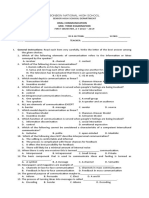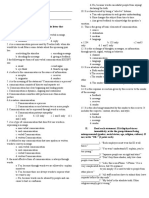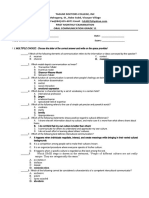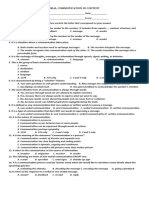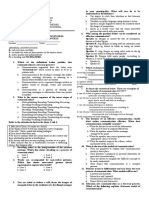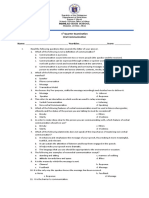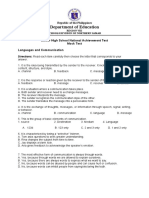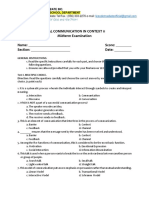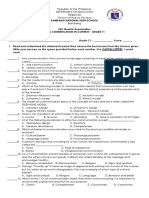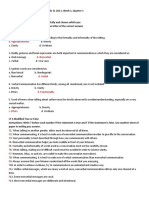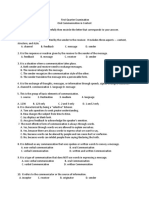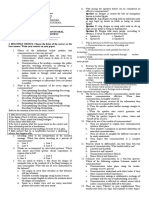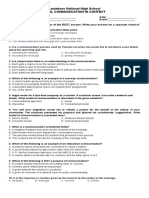Department of Education
Division of Dinagat Islands
VALENCIA NATIONAL HIGH SHOOL
Valencia, Cagdianao, Dinagat Islands
ST
1 EXAMINATION IN ORAL COMMUNICATION
GRADE 11
S.Y. 2022-2023
Directions: Read and comprehend each question. Choose the correct answer by shading the
letter that corresponds to your answer on the answer sheet.
1. Which model shows a one-way communication where the source of information does
not know whether the message is understood or not?
a. Linear c. Shannon-Weaver
b. Transaction d. A and C
2. The factors that affect the flow of communication.
a. Barrier c. Feedback
b. Encoding d. Decoding
3. When is a communication considered failed?
a. A negative feedback was given by the recipient of the message.
b. Both sender and receiver continue the conversation process.
c. The persons involved fixed the problem that provoked in the process.
d. The recipient did not decode the meaning of the message sent.
4. It is when an idea or information is translated into words and expressed to others.
a. Encoding c. Decoding
b. Channel d. Context
5. When the idea or information is understood and interpreted by the receiver.
a. Encoding c. Decoding
b. Channel d. Context
6. It is the idea being transmitted by the sender to the receiver. It includes three aspects
— content, structure, and style.
a. Channel c. Message
b. Feedback d. Sender
7. It is the response or reaction given by the receiver to the sender of the message.
a. Feedback c. Receiver
b. Message d. Sender
8. It is a situation where a communication takes place.
a. Both sender and receiver need to exchange messages.
b. The receiver interprets the message.
c. The sender recognizes the communication style of the other.
d. The sender translates the message into a perceivable form.
9. This is the group of basic elements of communication.
1. source
2. destination
3. medium
4. language
a. 1234 c. 123 only
b. 2 and 3 only d. 1 and 2 only
10. The following are forms of non-verbal communication EXCEPT one.
a. e-mail c. road signs
b. eye blink d. thumbs up signs
�11. It is characterized by being a “selective” listener.
a. Jun asks questions to seek greater understanding.
b. Jhonas changes the subject from time to time.
c. Ivy displays a blank look.
d. Rica gives feedback to acknowledge the speaker’s emotion.
12. The most effective form of communication is always through words.
a. Yes, because through words we are allowed to explain ourselves.
b. Yes, because there are always words to express what we want to say.
c. No, because words can be abused by people and can cause confusion.
d. No, because words can inhibit people from saying/declaring the truth.
13. It is defined as any communication that uses spoken or written words to convey a
message.
a. non-verbal communication c. written communication
b. verbal communication d. A and B only
14. It is a type of communication that does NOT use words in expressing a message.
a. non-verbal communication c. written communication
b. verbal communication d. oral communication
15. It is the nature of communication.
1. Communication is a process.
2. Communication occurs between two or more people.
3. Communication can be expressed through words or actions.
4. Communication portrays sympathy.
a. 1234 b.123 only c. 2 and 3 only d. 1 and 2 only
17. If the greetings “hello” is from USA, “hola” is from Spain, and “ciao” is from _____?
a. France c. Italy
b. Arabian d. Slovakia
18. Sam was a newly hired employee in a company. When he met his boss for the first
time, he told him “Hey, dude. What’s up? You’re lucky to have me here”. What can you
infer on Sam’s use of language in conversing with his boss?
a. Sam was just trying to be friendly to his superior.
b. It is okay to talk that way. Sam was only being honest and confident.
c. There is nothing wrong with how Sam talked to his boss. Employees should
create a close relationship with their bosses.
d. Sam should have used suitable language in communicating with his superior as
it manifests gesture of respect and professionalism.
19. It is the meaning of the statement “Communication is a process”.
a. Communication consists of discrete and separate acts.
b. Communication has clear beginning and ending points.
c. Communication is dynamic, ongoing and continuous.
d. Communication resembles still pictures more than motion picture.
20. It is an element of communication that convey messages by converting their thoughts
into symbols or observable signal such as words.
a. receiver c. recipient
b. sender d. message
21. It is a communication process used by Ms. Loida when she would like to ask Nicole
some details about the upcoming quiz bee.
a. activating the stimulus c. encoding the message
b. decoding the message d. giving the feedback
� 22.The function of communication that facilitates people’s expressions of their feelings.
a. Social interaction c. Motivation
c. Control d. Emotional expression
23. It is known when the receiver gives a verbal or non-verbal message.
a. answer c. reply
b. feedback d. barrier
24. These are considered forms of communication.
1. talking clearly 3. sending emails
2. chewing gum 4. looking bored
A . 1234 B. 134 only C. 342 only D. 1 only
25. Effective communication happens when the message is supported by facts, figures,
and real-life examples and situations.
a. Concreteness c. Clearness
b. Correctness d. Conciseness
26.It is the content of the communication.
a. jargon c. message
b. media d. noise
27. In this stage in (DMIS), the individual is very open to world views when accepting
new perspectives.
a. Acceptance c. Integration
b. Adaptation d. Open-mindedness
28. It is a good indication that good communication occurs.
a. destructed c. unreceived
b. confused d. shared
29. It is a two-way process of connecting to both living and non-living things. It is also a
means of sharing and exchanging messages, information, ideas, and feelings for mutual
understanding (Gregoriom, J.C., 2015).
a. Process of Communication c. Communication
b. Shannon-Weaver d. Transaction
30. This communication type is characterized by a certain look or gaze.
a. non-verbal Communication c. oral Communication
b. verbal Communication d. written communication
31. It is the sending and receiving of messages across languages and cultures.
a. Intercultural communication c. Inter cultural communication
b. Intracultural communication d. Inter cultural sensitivity
32. This is the BEST way to continue communication.
a. asking questions c. active listening
b. not interrupting d. making good eye contact
33. It is an indication that communication really takes place.
a. when the message enters the channel
b. when the message leaves the channel
c. when the receiver understands the message
d. when the sender transmits the message
34. What is the BEST solution to repair the communication breakdown?
a. Answer the questions asked.
b. Use the layman’s terms or simpler words.
c. Translate in Filipino language
d. None of the above
�35. This is to be avoided for effective communication.
a. ambiguity c. politeness
b. listening d. sharing of activity
36. Which element is NOT found in Shannon-Weaver model?
a. barrier c. feedback
b. channel d. receiver
37. Why do we need to be interculturally competent?
a. To avoid future misunderstandings with other people from different cultural
background.
b. To make friends with everyone.
c. To increase self-awareness of our own culture.
d. A and C only
38. A strong wind struck as Reneboy and his father took turns in pulling the fishing boat to
the shore. Reneboy cannot hear his father’s voice. Which affects the flow of the
communication process?
a. Reneboy’s voice c. boat
b. father d. wind
39. CJ submitted his report to his teacher online because of the enhanced community
quarantine. Which element is missing in the process?
a. channel c. encoding
b. feedback d. receiver
40. The Enhanced Community Quarantine (ECQ) frightened many people here and there. On
his social media account, Julius posted a status of dismay. Many supported his claim, but
others opposed it. His status acquired a hundred reactions and the comments thread rose to
75. What model of communication is exemplified?
a. Berlo’s Model c. Shannon-Weaver Model
b. Schram Model d. Transaction Model
41. In the situation given in #40, what element of communication is NOT present?
a. barrier c. feedback
b. context d. receiver
42. Which of the following is NOT a purpose of communication?
a. It connects the gaps among persons involved.
b. It narrows down issues and addresses it.
c. It offers solution to the community problems.
d. It paves a way to conflict.
43. What happens when the message is NOT clearly conveyed?
a. The communication continues.
b. The communicators end the communication process.
c. The recipient may get the wrong information to share with others.
d. The situation will never change.
44. Which model of communication shows the interchange of ideas among different
individuals and shows progress in the process?
a. Interactive c. Transaction
b. Linear d. NONE of the above
45. Which of the following is NOT a purpose of communication?
a. It creates blunder that worsens an existing issue or concern.
b. It fosters good relationship among people.
c. It gears towards the solution to a problem.
d. It gives an overview of a national issue for public understanding.
�46. A friend’s Facebook status caught your attention. It is intended for you. It is personally
attacking you. To put the purpose of communication into context, what is the best thing you
should do?
A. Immediately comment on his/her status with provocative words.
B. Inform him/her that you are going to sue him/her in court.
C. Talk to the concerned person privately to settle the conflict.
D. Tell the public about his/her dishonest way of life.
47. On your way home, you dropped by a convenient store. Queuing to pay for some
essentials, you heard a customer arguing with the cashier. The customer talked on top of his
voice complaining for something you could not clearly hear. The buyer next to him
interrupted the one complaining. The others in the line could not help but gave their own
sides of the story. Finally, the manager came in. What model of communication is presented
in the entire scenario?
A. Interactive C. Occasional
B. Linear D. Transaction
48. From the given situation above in #47, what should the manager do?
A. Arrogantly confront the customer for being tough.
B. Publicly reprimand the cashier to show that the customer is always right
C. Tell the other customers to stop gossiping.
D. Respectfully pull out the customer and look for a win-win solution to the problem.
49. These are issues like trauma, lack of confidence, fear, anger, frustration, and depression
that may affect the communication process.
A. use of jargon C. forda sad ang ferson
B. emotional barriers D. semantic Noise
50. In order to be an effective speaker, you should always ___________ significant
information about your receiver’s mood, race, background, preferences, education, and
others.
A. consider C. rate
B. hold D. think
GOOD LUCK AND HAVE FUN!!!









